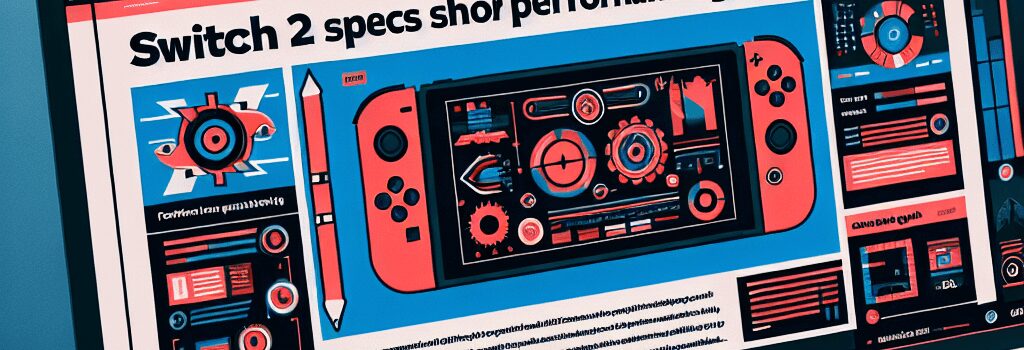Switch 2 Specs Show Performance Gap Undocked

With Nintendo’s official spec sheet and Nvidia’s high-level blog post offering limited data, Digital Foundry’s latest deep dive provides the most detailed confirmation yet of Switch 2’s final hardware. The analysis not only corroborates years of leaks but fills in critical technical gaps, revealing a system built around custom silicon optimized for mobile gaming.
By the Numbers: CPU, GPU, and Memory Bandwidth
Digital Foundry’s breakdown highlights the stark contrast between docked and undocked performance:
- CPU Clocks: 998 MHz (docked) vs. 1101 MHz (undocked)
- GPU Clocks: 1007 MHz (docked) vs. 561 MHz (undocked)
- Memory Bandwidth: 102 GB/s (docked) vs. 68 GB/s (undocked)
- Ray-Tracing Throughput: 20 gigarays/s (docked) vs. 10 gigarays/s (undocked)
- Peak TFLOPS: 3.072 TFLOPS (docked) vs. 1.71 TFLOPS (undocked)
Under the hood, Switch 2 harnesses an 8-core ARM Cortex-A78C CPU and a custom Ampere-based GPU with 1536 CUDA cores, paired with 12 GB of LPDDR5X memory on a 128-bit bus. Compared to the original’s Tegra X1-derived Maxwell GPU, this translates to a 6× uplift in compute cores and a 4× memory bandwidth increase when docked.
Thermal Design and Active Cooling
To sustain peak clocks, Nintendo’s new dock integrates an active cooling solution with a centrifugal fan and heat pipes. The system maintains a Thermal Design Power (TDP) of approximately 15 W in docked mode, versus a 10 W limit undocked. Thermal imaging by iFixit suggests the dock’s vapor-chamber design keeps GPU temperatures under 80 °C during extended sessions, while the handheld alone can reach throttling thresholds near 85 °C under heavy load.
Power Efficiency and Battery Life
Portable operation relies on a 40 Wh battery pack driving the console through two voltage rails—1.1 V for the CPU and 0.9 V for the GPU. Under typical gameplay, users can expect 4–6 hours of runtime, dropping to 3.5 hours with ray-tracing demos. Dynamic voltage and frequency scaling (DVFS) on the Cortex-A78C cores helps balance performance and power draw, similar to modern smartphone SoCs.
Developer Tools and Overclocking Potential
Nintendo reserves 25% of CPU cores and system memory for the OS, along with an undocumented slice of GPU resources. The SDK includes a Game Chat tool to simulate API latency, L3 cache contention, and audio/video decoding load. Digital Foundry notes theoretical headroom for 1.4 GHz GPU and 1.7 GHz CPU clocks—potentially unlocked via firmware updates or third-party patches, though thermal and power constraints will limit sustained overclocking.
Comparative Analysis Against Competitors
Against Valve’s Steam Deck 2 (RDNA 2 GPU, ~1.6 TFLOPS, 5500 mAh battery) and the Asus ROG Ally (AMD Z1 Extreme, 3.7 TFLOPS), Switch 2 holds its own in docked mode but trails in standalone GPU performance. Unlike its rivals, the Switch 2’s HDMI output currently lacks VRR support, though recent Valve firmware updates and AMD driver releases hint that Nintendo could enable HDMI VRR and 4K @ 60 Hz in a future system update.
Expert Opinions and Future Outlook
Industry analysts like Jon Peddie Research highlight Nintendo’s choice of LPDDR5X as a win for bandwidth-constrained titles, while ARM experts praise the A78C’s predictive branch architecture for reducing stalls. Looking ahead, titles optimized for the extra shader units and hardware ray-tracing could narrow the docked-versus-portable gap—even as Nintendo’s design philosophy prioritizes seamless portability over raw power.
As the Switch 2 prepares for its global launch next month, the true test will be how developers exploit this hybrid platform’s unique silicon, thermal headroom, and docking capabilities. We’ll be monitoring performance benchmarks and firmware updates closely as more games arrive on shelves.